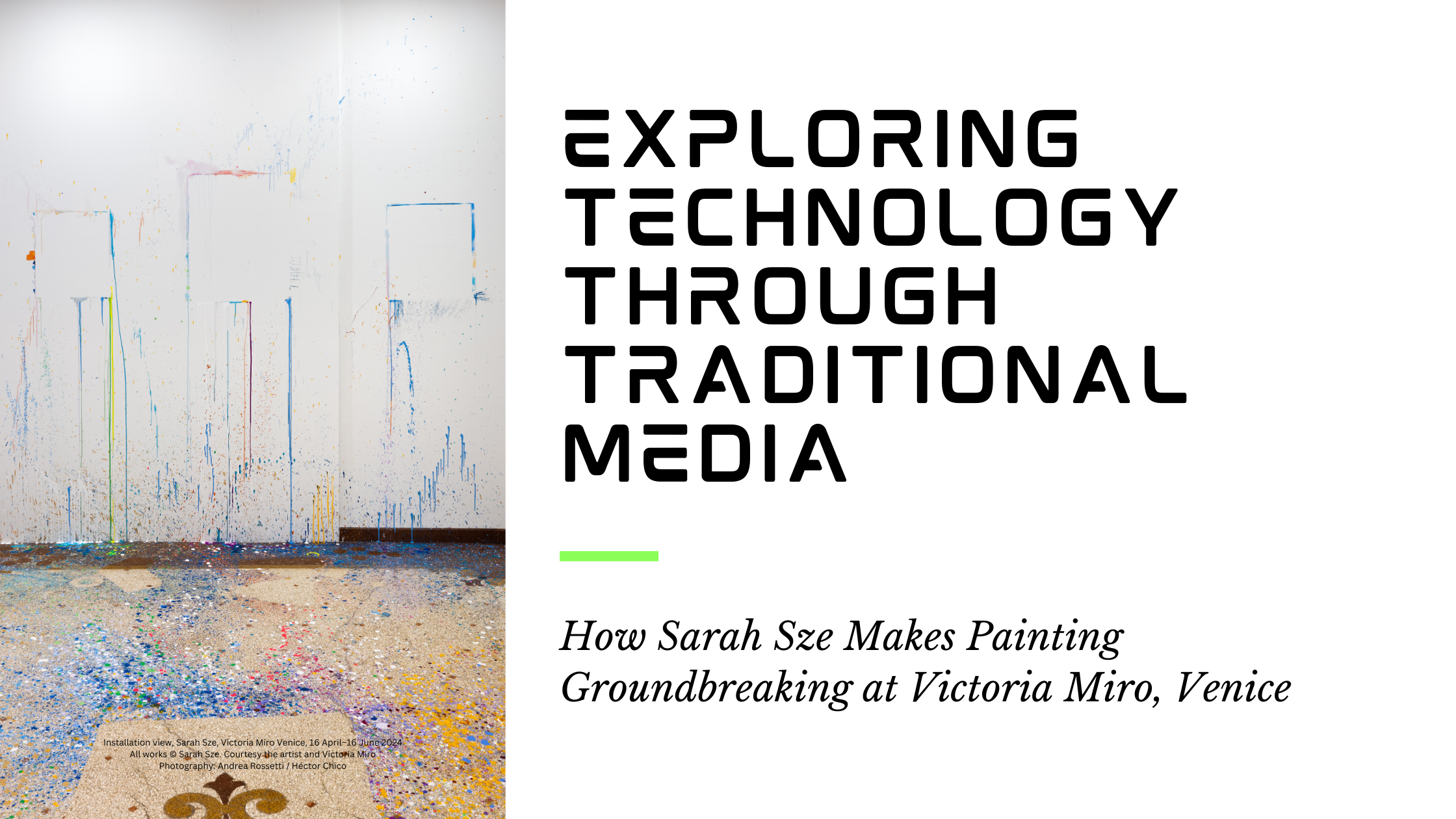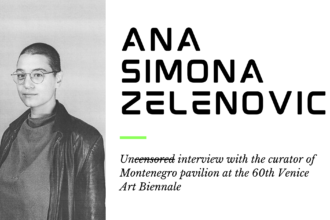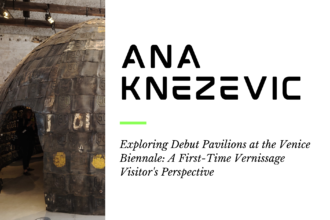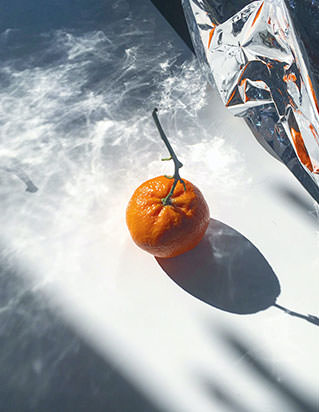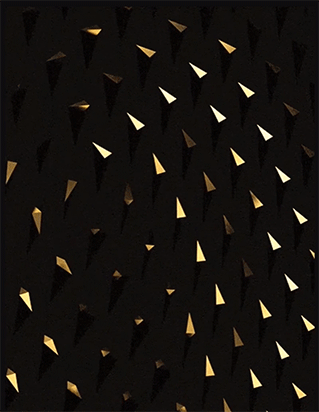A Vortex of Cognition: Exploring Technology Through Traditional Media
Lidija Ristić delves into Sarah Sze’s latest exhibition, “The Lost Paintings,” at Victoria Miro, Venice. Known for her multimedia installations, Sze presents a series of traditional paintings that challenge and expand her artistic practice. This exploration highlights Sze’s innovative use of materials and techniques, blending analog and digital elements to create illusionistic spaces. Ristić’s text offers a thoughtful analysis of how Sze continues to push the boundaries of contemporary art, providing readers with insights into the unique aspects of her latest works.
How Sarah Sze Makes Painting Groundbreaking at Victoria Miro, Venice
At the street level entrance to Victoria Miro, Venice you will be welcomed by a quintessential Sarah Sze installation. This comparatively paired-down monofilament and hand-torn paper construction, filling out the gallery’s main space, follows the tradition of Sze’s well-known body of work. This boldly positioned installation thoughtfully incorporates video projection and is an example of the artist’s skillful use of perspectival play. In this case two patchwork planes intersect at the far end of the gallery. Their point of convergence is a lattice framed window looking out onto a Venetian canal. The window’s four-sided framework adds another layer of repeating shapes to the mesmerizing dance of projected video and hovering pages.
Take a meditative moment to sit in the calm of the half-light while moving images dance across suspended rectangular fragments that cast a multicolored penumbra over the walls just behind them.
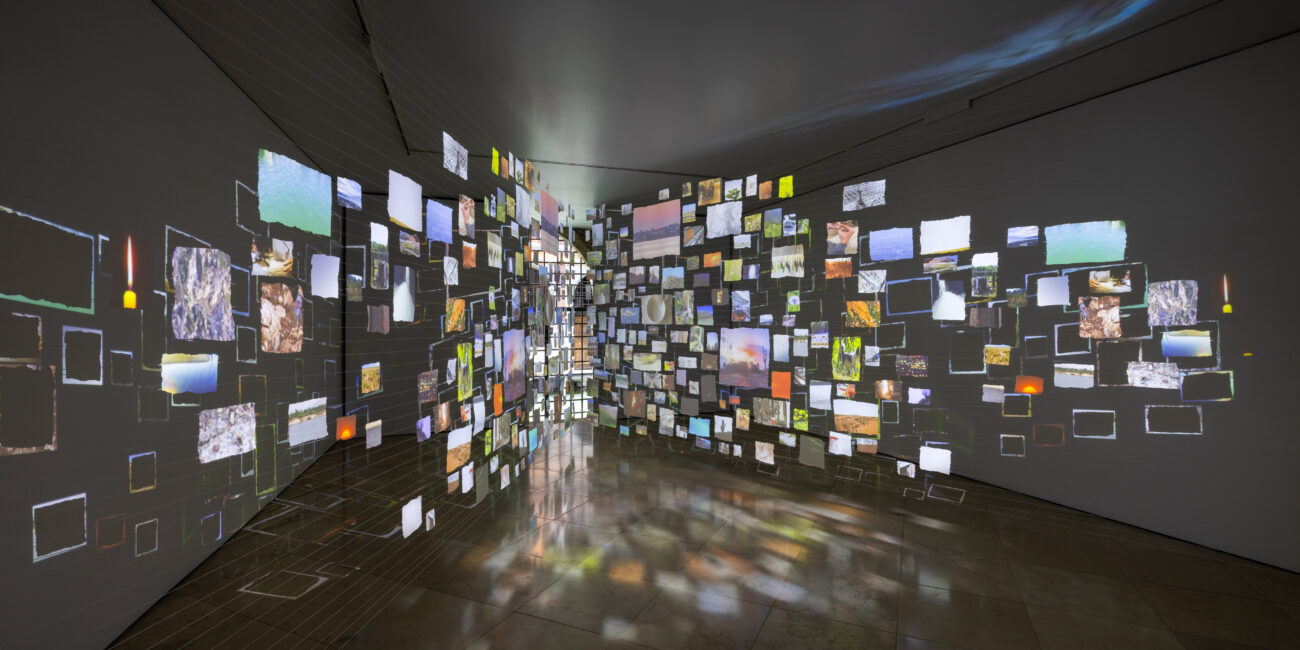
Installation view, Sarah Sze: Sleepers, 2024, Victoria Miro Venice, 16 April–16 June 2024© Sarah Sze.
Courtesy the artist and Victoria Miro
Photography: Andrea Rossetti / Héctor Chico
But do not make the same mistake I did in thinking that this is the entirety of Sze’s exhibition at Victoria Miro. Across the narrow Venetian street and up a short flight of stairs, tucked away within three inmate apartment rooms, awaits a completely distinct world to the one below it.
As someone who is mainly familiar with Sze’s sweeping, richly meticulous, multimedia and often kinetic installations, this mono-disciplinary showcase of, yes paintings, was a discovery. It doesn’t matter how many times they have been (and most probably will continue to be) declared dead by artworld pundits, painting still proves fertile ground for continued discovery. At least that is what Sarah Sze makes abundantly clear with her show, The Lost Paintings.
Over the course of her career, Sze has explored how technology and in particular, information technology, shapes contemporary life. Since the turn of the millennium, she has been a leader in interdisciplinary art making which continued the media-mixing and barrier-breaking methodologies established by Modernism and Postmodernism: most notably in regards to the use of the ready-made found object and assemblage. Over the past 30 years, Sze’s work has utilized unconventional materials like, ladders, scaffolding, tape measures, plants, plastic post-consumer products, and was among the first to incorporate video and light into installation work of its kind.
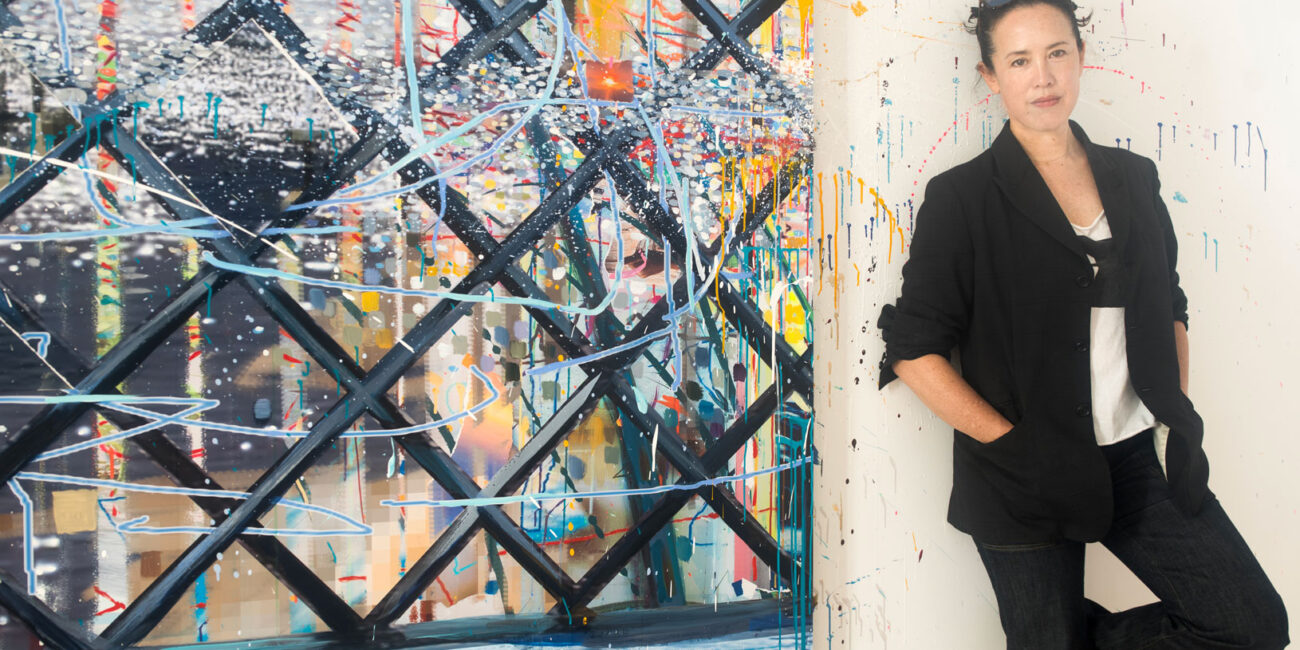
Sarah Sze, Venice, 2024 Portrait © Vincente de Paulo
Courtesy the artist and Victoria Miro
At the top of that staircase you will be greeted by an almost empty hallway. The only element present: paint. Drops, splatters and drips. The walls and floor are covered in a frenetic constellation of marks that are reminiscent of the work of Katharina Grosse and even Jackson Pollock. This gallery of ghost paintings is in fact a site-responsive wallpaper installation made from photographs of the walls of Sze’s New York city studio. However, not all the marks were made overseas. After the wallpaper was installed, the artist closed herself inside the apartment and not only completed the hung paintings with fresh paint strokes, she also created the (otherwise unplanned) drip composition on the vintage venetian floor.
We have seen artists bring in elements of their work space into an exhibition. We have seen dripping paint work and passive indexical marking making many times before. Yet, there is something very Sze about the treatment of this anteroom. Indeed the fact that we are being shown the “negative” before the “positive” is evocative of the artist’s use of media and photography. A balance of energetic broad strokes with more intimate tender ones is also emblematic of her practice: the clustering many coming together into faintly, almost undefined, units.
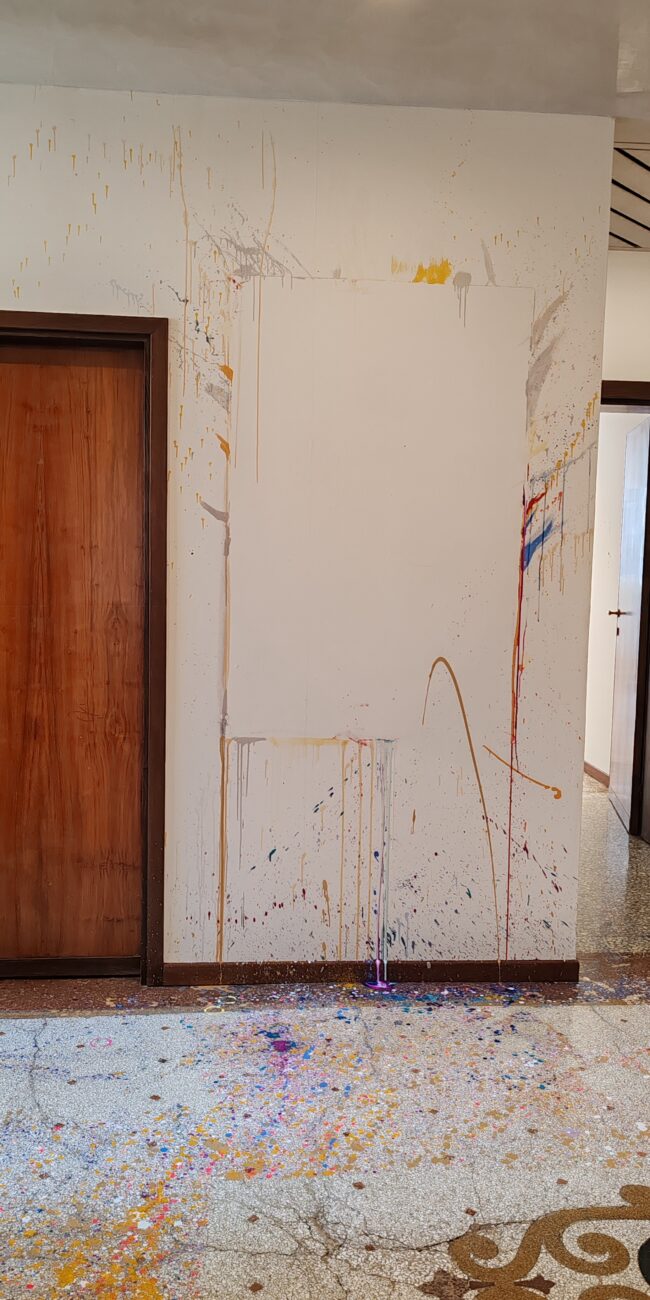
Entrance to The Lost Paintings, Sarah Sze, at Victoria Miro, Venice Photo by Lidija Ristić
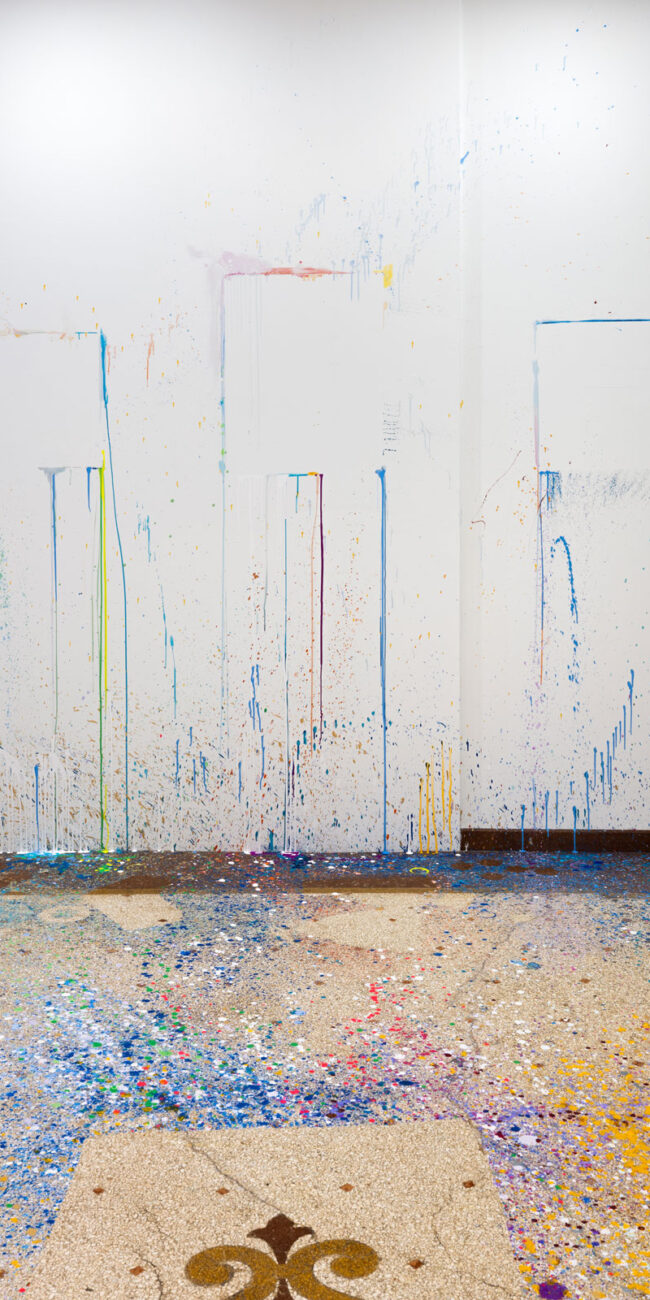
Installation view, Sarah Sze, Victoria Miro Venice, 16 April–16 June 2024
All works © Sarah Sze. Courtesy the artist and Victoria Miro
Photography: Andrea Rossetti / Héctor Chico
Over the threshold inside the main exhibition space something quite different comes into view. Although Sarah Sze has often used paper and paint and has made 2d works, like collages, in the past, all these works have been typified by a distinct and intentional lack of mark making. Indeed, Sze’s style could be called minimally interventionist; one in which the artist’s hand and its efforts are masterfully hidden. The results of this approach yield tableaus in which it appears as though the materials themselves are the ones orchestrating the complexly delicate compositions.
However, one major point of departure from her past exhibitions and this body of work is the use of traditional rendering techniques and the presence of illusionistic space. Indeed, there is a drastic shift from one room to the next. In the two back spaces we can see something that was intentionally excluded from the piece in the anteroom: the presence of the artist’s hand.
The Lost Paintings continues Sarah Sze’s tradition of layered material use, rich perspective crafting and innovative use of mixed media. It also incorporates the very noteworthy addition of rendering. Apart from revealing her presence in the production process, this addition also represents a major shift in which Sze is not just using materials as they are; as ready-mades. She is actively using materials to create the illusion of something else in a more traditional approach to material manipulation.
This introduction of illusionary imagery is deftly folded into trompe-l’œil-esque landscapes that ebb between realistic and semi-abstracted spaces. Layers of both splattered, dripped and manulated paint are both sharply contrasted and enhanced by the presence of torn color photographs and stacks of paper complete with their clips.
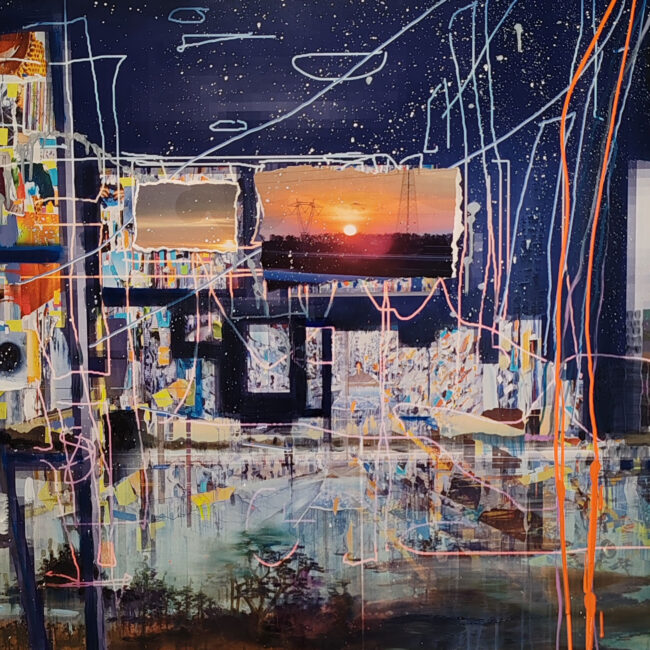
Sarah Sze, Swivel, 2024. Photo by Lidija Ristić
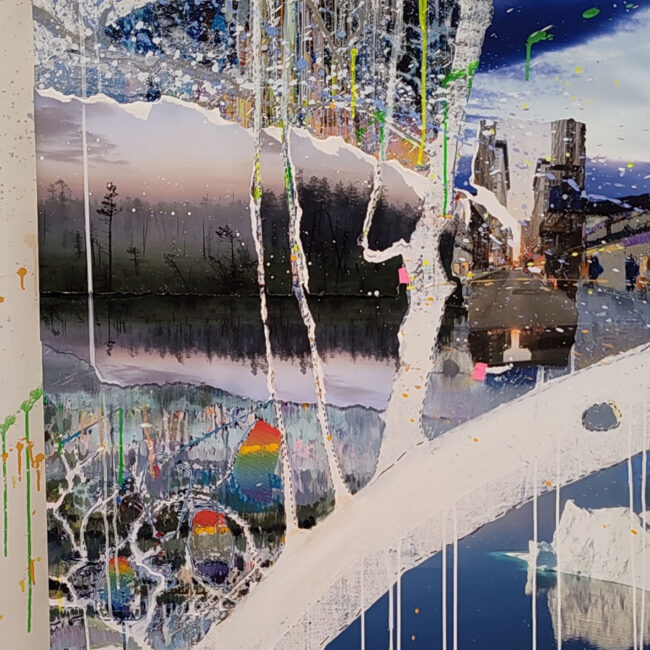
Sarah Sze, Night Vision, 2024. Photo by Lidija Ristić
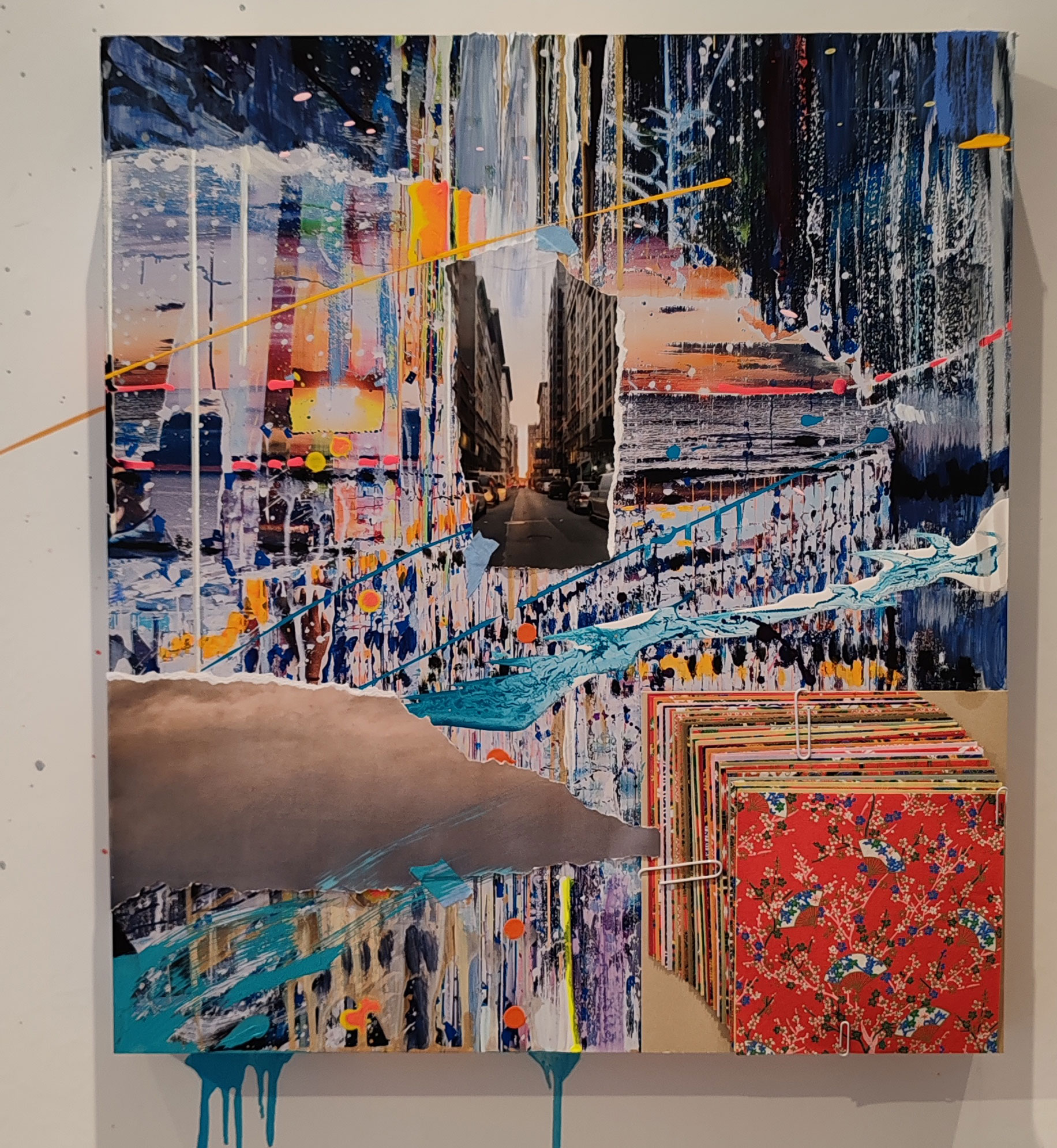
Sarah Sze, Sliver, 2024, Photo by Lidija Ristić
What is so exciting to see, from a long time fan like myself, is how clearly Sze these paintings are. There is a very distinct through-line between these compositions and her mutli-media installations: the presence of ovular, almost orbital-like forms that impart a near-dizzying implied movement and guide the eye through richly layered universes of collaged realities. In her installations they appear as wooden and plastic elements from which other materials are suspended. In her paintings these forms are present most notably in Unravel, 2024 as blue strokes that look like they could be digital brush/stylus marks- rendered in paint.
Many of Sze’s most well known installations come together as dense constellations of materials that seem to delicately swarm together. These, often suspended, composite entities appear as though they could dissipate again into their individual elements at any moment. Indeed as you approach, they seem to dissolve away from each other as you lose sense of the whole and become focused on its respective parts. It is only from a distance that we can behold them as a unit.
This effect is also present in the body of work on display at Victoria Miro. With each painting you can get lost within the intricate layers of details and be very happy to do so. However, when you are able to pull yourself out of that mesmerizing micro-world, another one awaits just one step backward. And then again another one when you take even more steps back after that.
Although this series of paintings uses more traditional materials and techniques, it still deals with technology and its impacts on our daily lives. In this case the artist is using her own personal experience for reference. Sze describes these paintings as the result of her going on a “digital diet”. One in which she was very conscious about what types of media she exposed herself to. This comes across in the work. Her stacked, canvas-bound realms are like a vortex of cognition. A mix of inputs, perspectives and experiences. The hands of the artist’s daughter, a chain-link fence, dream-like forest scenes, sunsets in multiple torn layers of hues. While at the same time they have the feel of a scrap/sketch book. Those imitate visual journals where we try to make sense of the visible world.
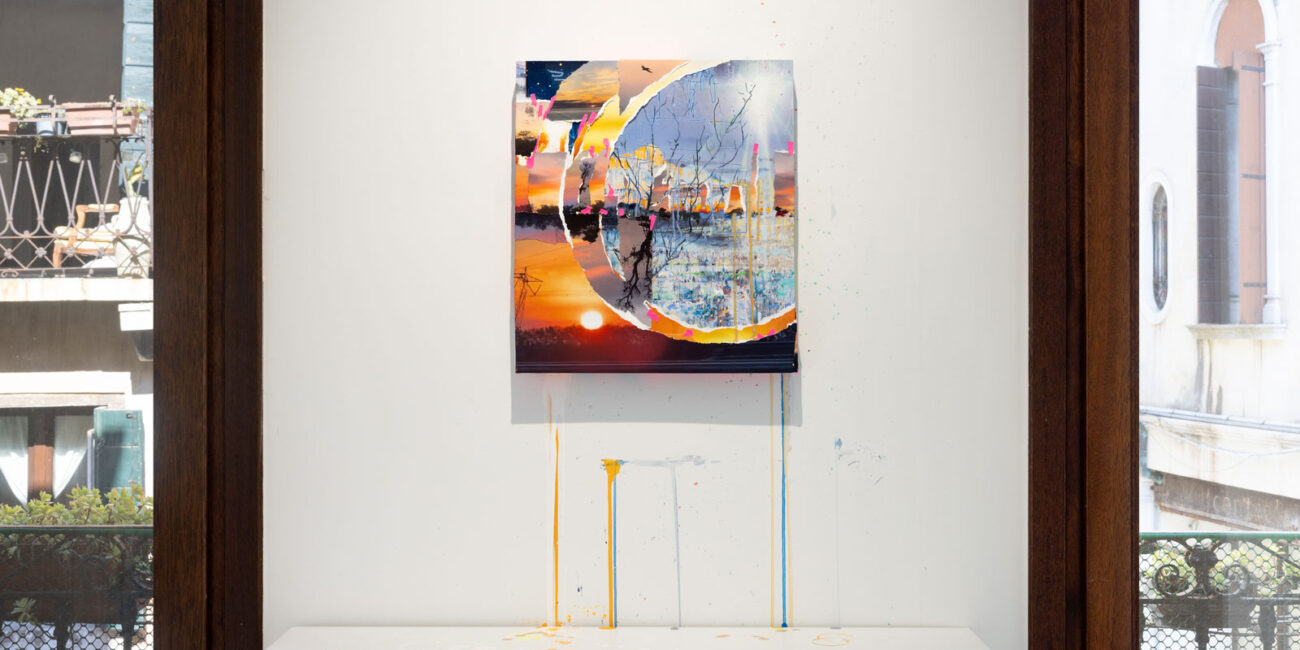
Installation view, Sarah Sze, Victoria Miro Venice, 16 April–16 June 2024 , All works © Sarah Sze.
Courtesy the artist and Victoria Miro
Photography: Andrea Rossetti / Héctor Chico
The work displayed in the main gallery is undeniably more technologically advanced. It continues Sarah Sze’s practice of blending information technology and quotidian objects.
However, I still find the work tucked away one floor above more groundbreaking. It is braver and bolder. Maybe precisely because it uses such traditional materials and approaches. Maybe it intrigues me all the more because it represents the courage of an artist to make an entire body of work without using any of the elements that she has built her career on. To the uninitiated, it may seem bizarre to say that Sze was taking a risk by presenting only paintings. In fact for someone in her position, there are few ways she could have taken any bigger risk.
What makes Sze’s latest series new and groundbreaking is not the techniques, materials or kind of technology being used. It’s something more elusive and less tangible. Perhaps it is simply that we have the opportunity to bear witness to that moment when an artist has honed their skills to the point where they can transcend techniques, materials and media. Maybe what we see on view is that exciting moment within an artistic practice when a balance between discipline and freedom is achieved. It is precisely at these moments that the work leaves us with ample space for reading between the lines.
Just as a shift in medium and dimension should, this exhibition gives us a new perspective on the riches of Sze’s universe. They each stand on their own, and enhance each other. There is no redundancy or over-tred ground. See how Sarah Sze maintains a rich tension between the analog and digital combined with a masterful integration of influences across the art historical canon.
Go to Victoria Miro to witness the confident exploration of a well seasoned artist who is taking on new challenges and finding fresh risks to tackle.

Installation view, Sarah Sze, Victoria Miro Venice, 16 April–16 June 2024 All works © Sarah Sze.
Courtesy the artist and Victoria Miro
Photography: Andrea Rossetti / Héctor Chico


